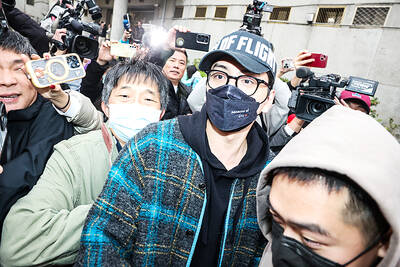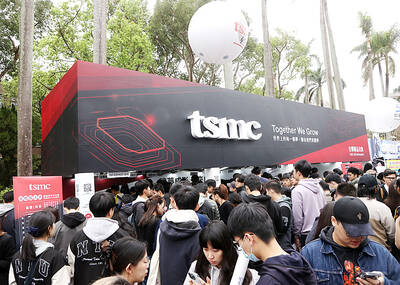A Taiwanese artist has released a fantasy comic book in France to great acclaim, receiving special nominations and acknowledgments at some of France’s most prestigious comic book fairs.
Released on Oct. 6 by publisher Patayo, Evergreen Yeh’s (葉長青) Lost Gods: Shen Mu, l’esprit de l’arbre is the first of a planned series of bilingual comic books that were inspired by Taiwanese folklore and written in Chinese and French.
Patayo is a French publishing house that has discovered talented artists from Taiwan, having released press cartoonist Stellina Chen’s (陳筱涵) political satire comic Dans la cour des grands (“In the Big Leagues”) in October.

Photo: CNA
Patayo’s founder, Frederic Fourreau, said that Taiwanese artists stood out with their abilities to blend different cultures and their willingness to tackle a wide range of genres.
What he liked most about Yeh’s storytelling, Fourreau said, was the author’s ability to transport European readers into a fantasy universe built on Taiwan.
“[Yeh’s work] fuses creatures from Japan, China and Taiwan’s Indigenous peoples,” Fourreau said, describing the read as “truly an enjoyable ride.”
The book was so well-received that Yeh was given a grant from the French government-run Centre National du Livre, which provides assistance to artists to create and promote their works, Fourreau said.
Yeh’s work also received special recognition at Paris’s Montreuil Children Book Fair, held from Nov. 29 to Monday last week.
From Dec. 1 to Dec. 3, the book brought Yeh to “Salon SOBD — Toute la Bande dessinee au coeur de Paris,” one of the biggest comic book fairs in France.
A comic artist, illustrator and academic, Yeh’s list of artistic accomplishments began with his enrollment at the University of Melbourne in Australia, where he studied oil painting.
Upon graduation, Yeh worked as a professional animator before becoming a full-time comic artist and illustrator.
Yeh’s most recognizable work is Mayfly Island (蜉蝣之島), a comic for which he received the Bronze Award at the 15th Japan International Manga Award in 2021.
In his latest work, Yeh takes his readers on an odyssey through the eyes of his protagonist who tracks down amnesiac spirits and deities.
The protagonist of the story was Yeh’s rendition of “Kui the Star,” an anthropomorphized celestial body from Taoist beliefs.
Kui took the form of a young girl in Yeh’s story, who located lost spirits to help them recover their forgotten memories before sending them home to heaven on a summoned vessel.
Before devoting his talents to Lost Gods: Shen Mu, l’esprit de l’arbre, Yeh worked with Taipei Legend Studio, where he illustrated one of the art house’s publications.
His time with the studio — a company focused on archiving Taiwan’s folklore — gave him the opportunity to map out the first manuscript of his story.
“I have always thought about how to push Taiwan’s stories to other countries,” he said. “Perhaps I could use yokai [spirits, creatures, monsters and demons] as a starting point and combine it with the fantasy art style which I like to pique the interest of foreign readers.”
Many of his French readers observed that the majority of yokai comics were dominated by Japanese books, which made Yeh’s Taiwan creatures all the more fascinating and alluring, he said.
Yeh added that he hopes to use new retellings of old stories based on new research and understanding to present Taiwan’s culture and legends to the rest of the world.
“Creating work that will be liked by both Taiwanese and foreigners alike, on top of deepening Taiwan’s own knowledge of their own domestic culture and legends to give them pride, is the ultimate goal which I thrive toward,” he said.

Actor Darren Wang (王大陸) was questioned by prosecutors for allegedly orchestrating an attack on a taxi driver after he was allegedly driven on a longer than necessary route in a car he disliked. The questioning at the New Taipei City District Prosecutors’ Office was ongoing as of press time last night. Police have recommended charges of attempted murder. The legally embattled actor — known for his role in the coming-of-age film Our Times (我的少女時代) — is under a separate investigation for allegedly using fake medical documents to evade mandatory military service. According to local media reports, police said Wang earlier last year ordered a

CAUTION: Based on intelligence from the nation’s security agencies, MOFA has cautioned Taiwanese travelers about heightened safety risks in China-friendly countries The Ministry of Foreign Affairs (MOFA) yesterday urged Taiwanese to be aware of their safety when traveling abroad, especially in countries that are friendly to China. China in June last year issued 22 guidelines that allow its courts to try in absentia and sentence to death so-called “diehard” Taiwanese independence activists, even though Chinese courts have no jurisdiction in Taiwan. Late last month, a senior Chinese official gave closed-door instructions to state security units to implement the guidelines in countries friendly to China, a government memo and a senior Taiwan security official said, based on information gathered by Taiwan’s intelligence agency. The

President William Lai (賴清德) should protect Taiwan Semiconductor Manufacturing Co (TSMC), and stop supporting domestic strife and discord, former president Ma Ying-jeou (馬英九) wrote on Facebook yesterday. US President Donald Trump and TSMC on Monday jointly announced that the company would invest an additional US$100 billion over the next few years to expand its semiconductor manufacturing operations in the US. The TSMC plans have promoted concern in Taiwan that it would effectively lead to the chipmaking giant becoming Americanized. The Lai administration lacks tangible policies to address concerns that Taiwan might follow in Ukraine’s footsteps, Ma wrote. Instead, it seems to think it could

Taiwan Semiconductor Manufacturing Co (TSMC), the world’s largest contract chipmaker, said yesterday that it is looking to hire 8,000 people this year, at a time when the tech giant is expanding production capacity to maintain its lead over competitors. To attract talent, TSMC would launch a large-scale recruitment campaign on campuses across Taiwan, where a newly recruited engineer with a master’s degree could expect to receive an average salary of NT$2.2 million (US$60,912), which is much higher than the 2023 national average of NT$709,000 for those in the same category, according to government statistics. TSMC, which accounted for more than 60 percent